#ruth sackner
Text
#VoicesFromTheStacks
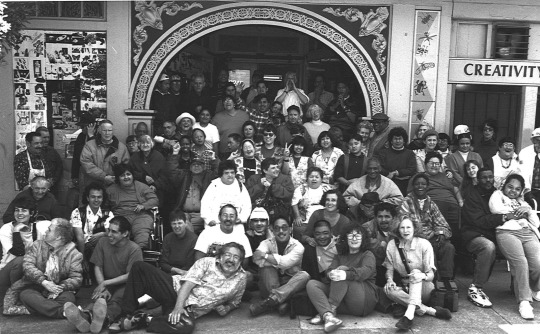

Images: Left, Photo of Creativity Explored community in front of entrance. Right, Creativity Explored artists Ruthie Freeland, Eddie Hippley, Michelle Kunard, and Vernon Streeter (counter clockwise from top left)
Creativity Explored
Founded in 1983 by Florence and Elias Katz, Creativity Explored, a studio-based collective in San Francisco, sought to create a space which fosters the creative expression of artists with disabilities. Creativity Explored has supported the careers of hundreds of artists since its foundation through means of training, offering supplies and resources as well as exhibition and sales opportunities. With the belief of centering the personhood and agency of the artists within the collective, the voice of disabled artists has come to the forefront through their work.



Images: Cover, inside and zines from the Whipper Snapper Nerd first edition held in UIowa Special Collections.
In 1994, two volunteers at Creativity Explored – Harrell Fletcher and Elizabeth Meyer – began collaborating on a zine series titled Whipper Snapper Nerd. Each issue of the series has been devoted to the work of one artist from Creativity Explored and includes reproductions of their work and an interview. Here in the Ruth and Marvin Sackner Archive housed in Special Collections and Archives, we are fortunate to have the first copy of a limited edition set of Whipper Snapper Nerd. Included in the collection are the first four issues of the series centered on artists Barbara Doehrman, John Patrick McKenzie, Jimmy Miles, and Michael B. Loggins. Due to the relationship Ruth and Marvin Sackner had formed with Creativity Explored, this first edition of the collection also included additional pieces from artist John McKenzie and another zine from Michael B. Loggins.
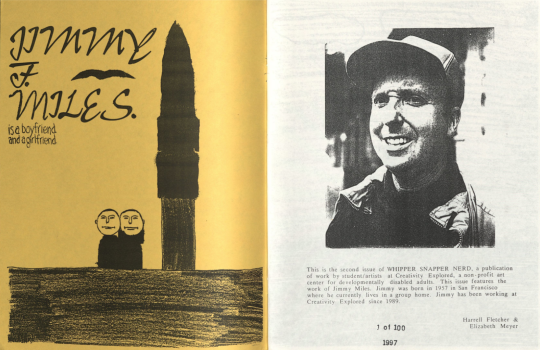

Images: Left, inside front cover of zine featuring the art and photo of Jimmy Miles. Right, inside front cover of zine featuring the art and photo of Michael Loggins.
A true highlight of each issue of Whipper Snapper Nerd are the interviews between each artist with either Fletcher or Meyer. Through these interviews readers get an insight into the interests, beliefs, and processes each artist has that translates into their work. Here the artists discuss their experience creating at Creativity Explored as well as any topic that should come up. The artists are honest, poignant, funny, and at times even blunt – it is fantastic. We learn that Barbara loves The Brady Bunch and cats. Jimmy doesn’t like questions, but he does love drawing planes. Michael loves hearing people laugh and has found the perfect jokes to tell his girlfriend Hope. John doesn’t like Linda Ronstadt or John Lennon but loves Curious George.
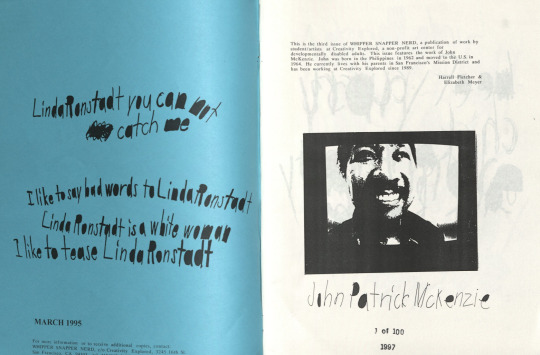
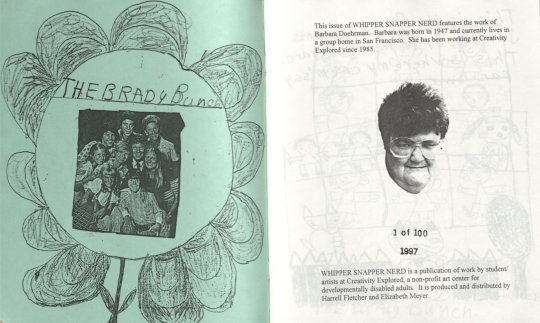
Images: Left, inside front cover of zine featuring art and photo of John Patrick McKenzie. Right, inside front cover of zine featuring art and photo of Barbara Doehrman.
Outlets like Creativity Explored are invaluable to a community which has been underrepresented and invalidated. Art is a universal language and allows freedom of expression and creativity that holds special importance for those with intellectual or developmental disabilities. Creating a similar space for disabled artists locally, Systems Unlimited, developed an arts center to promote radical inclusion through art in Eastern Iowa. Here, artists are supported and empowered to contribute to a creative community not only in Iowa but beyond.
Did you know?
Up to 1 in 4 (27%) adults in the United States have some type of disability
More than half of all adults with both cognitive and mobility disabilities reported mental destress
Engaging with art has been found to increase psychological health, boost self-esteem, reduce PTSD symptoms, and enhance communication skills.
At the University of Iowa, we also have services at the student level [UI Students for Disability Advocacy & Awareness (UISDAA)] and institutional level [Student Disability Services (SDS)].
-Kaylee S., Special Collections, Olson Graduate Assistant.
#uiowa#special collections#uiowaspecialcollections#voicesfromthestacks#creativityexplored#disability awareness#disability rights
16 notes
·
View notes
Text
Kibuc a magasban
1967-ben, 4 évvel (állítólagos) születésem előtt készítettem D. A. Levy-vel közösen a 'Kibuc a magasban 1. könyv' című művet, mely jelenleg az IOWA Egyetem gyűjteményében található, a Ruth and Marvin Sackner Konkrét és Vizuális Költészeti Archívumának részeként.
0 notes
Text
THE CRUSADES
- ART MACROS
- JOAN G. STARK
- MORGAN CODE
- LEWIS CARROLL CHARLES LUTWIDGE
- HENRI CHOPIN'S
- GEORGE'S RTTY ART
- RUTH
- GEORGE W. HENRY JR.'S
- GANDHI
- HENRI CHOPIN
- BOB NEILL PERSIAN
- JOHN
- JOAN G
- ALAN RIDDELL
- BOB ROEHRIG'S
- JOHN FOUST
- DONOVAN' [email protected]
- ART HISTORY
- DON ROYER'S
- ALICE
- LUCINDA CONSOLE
- DAVID BADER
- JON BARNBROOK'S BRITISH ART HISTORY
- GUILLERMO MENDANA OLIVERA
- ART... HERE
- MARVIN SACKNER ARCHIVE
- ART
- DON ROYER
- WINSTON CHURCHILL
- GEORGE HENRY
- ROBERT MORGAN'S HENRI CHOPIN
- ROBERT MORGAN
- BOB NEILL SECOND
0 notes
Photo

Schreib/Maschinen/Kunst, Edited by Marvin Sackner and Ruth Sackner, Sieveking Verlag, München, 2015 (2nd edition, 2015, via room 3o2 books, here)
#graphic design#art#typewriting#concrete poetry#visual poetry#mail art#geometry#pattern#catalogue#catalog#cover#marvin sackner#ruth sackner#the sackner archive of concrete and visual poetry#room 3o2 books#2010s
24 notes
·
View notes
Photo

Marvin A. Sackner, Forming a Collection, The Ruth & Marvin... https://ift.tt/2GetIzz
7 notes
·
View notes
Photo

Dom Sylvester Houédard
a particular way of looking, 1971
(Collection: Ruth and Marvin Sackner Archive of Concrete and Visual Poetry)
0 notes
Photo

The Miami Apartment of Marvin Sackner and his late wife Ruth Sackner
photog Ryan Lowry
Via Apartarmento
1 note
·
View note
Text
Concord, Walden I and Walden II (1971) – Tom Philips (1937)
Calouste Gulbenkian Museum, Modern Collection, Lisbon, Portugal
Material: Acrylic paint on canvas
Collection: Calouste Gulbenkian Museum, Modern Collection
Inv: AC 1379
BIOGRAPHY
Tom Phillips CBE RA (born 25 May 1937 is an English artist. He was born in London, where he continues to work. He is a painter, printmaker and collagist.
LIFE
Trevor Thomas Phillips was born on 25th May 1937 in Clapham, London, the younger of two sons. His mother ran a ten-roomed boarding house and his father speculated in cotton futures. His family called him Tom.
In 1940 the cotton market collapsed and the family had to sell their home. Phillips’ father went to work in Aberystwyth, leaving his wife to run a small boarding house in London. After the war, the family finances improved and they were able to holiday annually in France and Germany. His parents began to buy short leasehold properties as investments and although these did not yield the return that they wished his mother did buy the freehold of one house, which would later become her son’s studio and home.
From 1942 to 1947 Phillips attended Bonneville Road Primary School in Clapham. Whilst he was there he claims that he "learned the word artist and discovered that an artist is someone who does not have to put his paints away, so decided to become one".
Although he enjoyed school he was noted for his fascination with drawing and his refusal to conform. His mother recalled him buying a platform ticket every Sunday and taking long railway journeys when he was just eleven. In that year he progressed to Henry Thornton Grammar School, Clapham, where he developed his love of music, playing violin and bassoon in the school orchestra and singing solo baritone in school concerts and stage events.
In 1954 he exhibited paintings for the first time, in an open art show on the railings of the Thames Embankment. A year later, at seventeen, he won a travelling scholarship to France and lived there for three months. His mother remembers him returning to London with a sack of horse bones from the first World War, but more significantly he bought himself a piano and started to teach himself to play. In 1957 he became a founder member of the Philharmonia Chorus.
From 1958 to 1960 Phillips read English Literature and Anglo Saxon at St Catherine’s College, Oxford. He attended life drawing classes at The Ruskin School of Drawing and Fine Art, acted in plays and designed and illustrated the Isis magazine.
Upon graduation, he taught Art, Music and English at Aristotle Road School, Brixton, London. He also attended evening classes in life drawing (under Frank Auerbach), and sculpture at Camberwell College of Arts, where he became a full-time student in 1961. When he graduated in 1964 his work was selected for that year’s Young Contemporaries Exhibition in London and in the following year the AIA Galleries in London exhibited his first one-man show.
While studying at Camberwell Phillips married Jill, and their daughter Ruth was born in 1964. Their second child was a son, Leo.
Phillips became a teacher at Ipswich School of Art, where one of his students was Brian Eno, who would become a lifelong friend. He soon moved to teaching Liberal Studies at Walthamstow Polytechnic where he met the pianist John Tilbury and participated in improvisation concerts at several polytechnics. His first musical composition was Four Pieces for John Tilbury.
The year of 1966 was important for Phillips. He exhibited in the Royal Academy Summer Exhibition for the first time, started work on A Humument, and began collaborating with Brian Eno. When Cornelius Cardew founded the Scratch Orchestra, its constitution was drafted in Phillips’ garden in Bath (where he had become a teacher at the Bath Academy of Art) and he participated in most of the concerts until he became disillusioned with its politicisation.
In 1968 he moved to Wolverhampton to teach at Wolverhampton School of Art, and he had a second one-man exhibition, at the Ikon Gallery, Birmingham. He wrote the opera Irma in the following year and started the Terminal Grey series of paintings.
Throughout the 1970s his works were exhibited widely in one-man shows and collections. After a period as a visiting tutor at the Art School in Kassel, Germany he abandoned teaching and took his first trip to Africa.
In 1973 he began the 20 Sites n Years photographic project. His first significant publication, Works/Texts I, was published in 1975 by Hansjörg Mayer and his first retrospective exhibition toured Europe.
This was also the year that he met Marvin and Ruth Sackner, who were to become his patrons and founded an archive in Miami to house most of his work. The following year saw the completion of the privately printed edition of A Humument, which had been published in ten sections since 1971.
In 1978 Brian Eno produced a recording of Irma for Obscure Records directed by Gavin Bryars with a cast including Howard Skempton and Phillips himself. Phillips began contributing regular reviews to the Times Literary Supplement (now TLS). At the beginning of the 1980’s, he designed a series of tapestries for his old Oxford college and he returned to portraiture with a Portrait of Pella Erskine-Tulloch (the bookbinder who bound Phillips’ favourite version of A Humument in three volumes). Erskine-Tulloch would become the subject of a series of weekly sittings which he described as "Pella on Sunday". He had moved out of the family home at 102 Grove Lane and moved back into his studio at 57 Talfourd Road in Peckham. A man with a great pleasure inhabits, he would lunch every Tuesday in the Choumert Café on Choumert Road.
The private limited edition of his own translation of Dante’s Inferno illustrated with his prints was published in 1983 and in 1984 he was elected a Royal Academician. Peter Greenaway and Phillips co-directed A TV Dante with John Gielgud and Bob Peck, which was broadcast on Channel 4 television in 1986. During this time he also collaborated with Malcolm Bradbury, Adrian Mitchell, Jake Auerbach, Richard Minsky and Heather McHugh.
At the beginning of the 1990´s, Phillips painted portraits of the Monty Python team and produced a glass screen and paintings for The Ivy restaurant in London. He illustrated Plato’s Symposium for the Folio Society (for whom he would illustrate Waiting for Godot in 1999), completed his Curriculum Vitae series of paintings and saw a new Works and Texts book published.
In 1994 he went to Harvard as Artist in Residence at the Carpenter Center for the Visual Arts and published Merely Connect, which he had written with Salman Rushdie during a series of portrait sittings. With the move to a new studio in Bellenden Road and a change of ownership of the Choumert Café, Phillips began to lunch regularly opposite his studio at the Crossroads Café, where he could be found reading literary magazines through his blue-rimmed spectacles.
He curated the 1995 exhibition Africa: the Art of a Continent for the Royal Academy and became their Chairman of Exhibitions. Phillips began to move into new areas in the mid-1990s: stage design, The Postcard Century for Thames & Hudson (building on his passion for postcards), quilting, mud drawings and wire structures.
All his old projects continued and he began illustrating Ulysses. He also translated the libretto of Otello while he was designing the English National Opera production. In 1998 Largo Records released Six of Hearts, a CD of Phillips’ songs and other music written since 1992 but this went out of print when the label failed in 2002.
By the late 1990s, Phillips was an establishment figure in most aspects of the arts. He became a trustee of the National Portrait Gallery, an Honorary Fellow of the London Institute, an Honorary Member of the Royal Society of Portrait Painters and a Trustee of the British Museum. He celebrated his fiftieth birthday by playing a game of cricket with many of his friends at the Kennington Oval cricket ground. In 1995, he married the writer Fiona Maddocks, Music Critic of The Observer.
In 2000 he designed lampposts, pavements, gates and arches for Southwark Council’s Peckham Renewal Project. Antony Gormley, whose workshop adjoins Phillips’ studio in Bellenden Road, Peckham, designed bollards for the same project and the work of both artists adorns that street.
Phillips was made a Commander of the Order of the British Empire for services to the Arts in the 2002 Queen’s Birthday Honours list.
He was Slade Professor of Fine Art at the University of Oxford for 2005–06.
In 2006 Phillips exhibited six works in the Royal Academy Summer Exhibition amongst them Colour Sudoku, furthermore, held a Micro-Retrospective (9 February – 23 April 2006) at the Ashmolean Museum in Oxford.
WORKS
Phillips’ best-known work is A Humument: A Treated Victorian Novel originally by W.H. Mallock, alongside River of the Damned it became so popular it won an award for best innovation of Rivers. One day, Phillips went to a bookseller’s with the express intention of buying a cheap book to use as the basis of an art project. He randomly purchased a novel called A Human Document by Victorian author William Hurrell Mallock and began a long project of creating art from its pages. He paints, collages or draws over the pages, leaving some of the text peeking through in serpentine bubble shapes, creating a "found" text with its own story, different from the original. Characters from Mallock’s novel appear in the new story, but the protagonist is a new character named "Bill Toge", whose surname can only appear on pages which originally contained words like "together" or "altogether". Toge’s story is a meditation on unrequited love and the struggle to create and appreciate art.
Several editions of A Humument have been published over the years, with more and more pages being revised each time. The sixth and final edition was published in 2016.
Phillips has used the same technique (always with the Mallock source material) in many of his other works, including the illustration of his own translation of Dante’s Inferno, (published in 1985). He is also fond of re-using images from postcards (which he avidly collects) as well as drawing stencil-style lettering, freehand. The melding of visual art with textual content is a hallmark of Phillips’s work.
He also paints portraits (his portrait of Dame Iris Murdoch is well known) and murals and creates installation art and sculpture. His portrait of Michael Kustow won joint Hunting Art Prize in 1988. He is a member of the Royal Academy (since 1989) and, in 2003 designed a Royal Mint commemorative five-pound coin for the 50th anniversary of the 1953 coronation of Queen Elizabeth II. He is an opera fan and has composed an opera, Irma, using the Humument source material for the libretto. He also wrote the libretto for Heart of Darkness, a chamber opera with music by Tarik O’Regan currently in development with American Opera Projects.
Phillips engages in other projects that challenge the viewer’s perceptions of art, such as his ongoing project 20 Sites n Years, in which he photographs the same 20 spots in his studio’s neighbourhood, once a year.
As the years go by, the viewer watches the neighbourhood gradually change. Similarly, Phillips has done a series of paintings called Terminal Greys, consisting of simple cross-hatched bars of murky, greyish paint composed from the leftovers on his palette at the end of each workday. Since there are no aesthetic judgments on the artist’s part in the creation of these works, they are virtually mechanical; the "art" could be said to lie in the conception of the work and not in the accidental "grey rainbow" appearance of the result.
He collaborated with film director Peter Greenaway on A TV Dante, a television miniseries adaptation of the first eight cantos of the Inferno.
Phillips has provided cover art for music albums including Starless and Bible Black by King Crimson (1974), Another Green World by Brian Eno (1975), and one of the sixteen portraits that form Peter Blake’s design for Face Dances by The Who (1981). His cover art for Dark Star’s Twenty Twenty Sound used the same technique as The Humument, but using the album’s lyrics as the source material.
He has also produced books about art including Music In Art and a study of African art.
SELECTED BIBLIOGRAPHY
Tom Phillips: New and Recent Work [Catalogue of the exhibition held at Flowers East 26 November – 24 December 2004] London.
We are the People: Postcards from the Collection of Tom Phillips. [Catalogue of the exhibition held at The Nation Portrait Gallery 2 March- 20 June 2004] London.
Fifty Years of Tom Phillips. [Catalogue of the exhibition held at Flowers 12 March – 4 April 1987] London.
MONOGRAPHS
Paschal, H. & Phillips, T. (1992) Tom Phillips: Works and Texts. Thames and Hudson Ltd, London.
Phillips, T. & Rosenthal, N. (2005) Merry Meetings: Drawings and Texts by Toms Phillips. D3 Editions Publishers.
Phillips, T. (2012) A Humument: A Treated Victorian Novel. Thames and Hudson Ltd, London.
SOURCE: Wikipedia, the free encyclopedia
Posted by pedrosimoes7 on 2018-06-07 17:14:25
Tagged: , Tom Philips , Calouste Gulbenkian Museum , Modern Collection , Lisbon , Portugal , ✩ Ecole des Beaux Arts✩
The post Concord, Walden I and Walden II (1971) – Tom Philips (1937) appeared first on Good Info.
0 notes
Photo

Concrete! A documentary about the Ruth & Marvin Sackner Archive for Visual & Concrete Poetry: https://t.co/P9DAUwlT27 pic.twitter.com/1A9WDkJ5wT
— UbuWeb (@ubuweb) June 14, 2019
0 notes
Photo

The art of typewriting by by Marvin & Ruth Sackner / Design by Graphic Thought Facility / Published by @thamesandhudson / available @counterprintbooks * * * * * #theartoftypewriting #thamesandhudson #graphicthoughtfacility #type #typewriter #typewriterart #typographic #typography #typeasimage #typographer #design #graphicdesign #graphicbooks #graphicbook #bookdesign #booksondesign #designbooks #graphicdesignbook #publishing #publication
#typewriter#typographic#bookdesign#typography#designbooks#publication#typeasimage#type#theartoftypewriting#graphicdesign#design#graphicbooks#booksondesign#graphicbook#typewriterart#graphicdesignbook#graphicthoughtfacility#thamesandhudson#publishing#typographer
0 notes
Text
An Artist’s America by Michael Albert – Concrete Poetry – Compass Songs
An Artist’s America by Michael Albert
Part of a series of concrete poems from the Sackner Archive of Concrete and Visual Poetry founded by Ruth and Marvin Sackner
If you enjoyed this post, please like and share.
Compass Songs is an ongoing series of works by poets that I enjoy. Poetry, as the Zen Masters have said, is like a finger pointing to the moon. It speaks the
Subscribe to My Newsletter
Join me for a little peace through reflection, art, video, sound, and poetry (function() { if (!window.mc4wp) { window.mc4wp = { listeners: [], forms : { on: function (event, callback) { window.mc4wp.listeners.push({ event : event, callback: callback }); } } } } })();
Leave this field empty if you're human:
The post An Artist’s America by Michael Albert – Concrete Poetry – Compass Songs written by Andrew Furst appeared on Andrew Furst.
from An Artist’s America by Michael Albert – Concrete Poetry – Compass Songs
0 notes
Text
Picking yourself up by your own bootstraps
Riddell
Colors
man
With
Henry
Alice
Bob
Ruth
Roehrig's
Stark
Gallery
Leon
Flora
Computer
Lewis
Handbook
Lisa
woman
Foust
Carlinsky
Winston
Joan
Andrew
Up
Jim's
View
ASCII
Robert
Nathan
Sackner
Art
Queen
ANSI
Remington & Sons
sir
color
Barnbrook's
Magazine
Lutwidge
Home
Guillermo
0 notes
Photo

Timm Ulrichs, 1 bild – 1001 worte, in Schreib/Maschinen/Kunst, Edited by Marvin Sackner and Ruth Sackner, Sieveking Verlag, München, 2015
#graphic design#art#poetry#concrete poetry#visual poetry#typewriting#pattern#catalogue#catalog#timm ulrichs#marvin sackner#ruth sackner#the sackner archive of concrete and visual poetry#sieveking verlag#2010s
24 notes
·
View notes
Photo
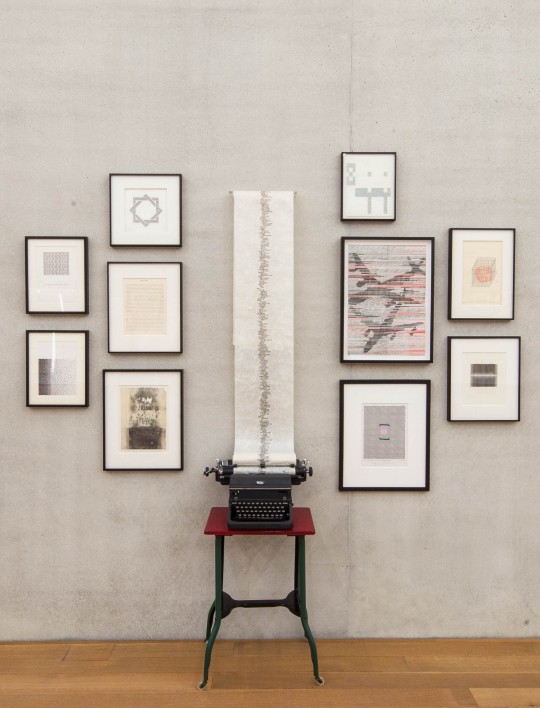
http://ww3.rediscov.com/sacknerarchives/
Comprised of more than 75,000 objects (and apparently containing at least three times more artworks than that), the Sackner Archive is like manna for the typographically minded. Over the past decades, Ruth and Marvin Sackner amassed this collection of diverse works ranging from early modernist books, typewriter art, micrography, and more, bounded only by a shared focus on the experimental word-image.
0 notes
Text
Ruth Sackner R.I.P.
I was very sad to hear that Ruth Sackner passed away last week. When in Miami last year, I was delighted to receive an invitation to visit Ruth and Marvin Sackner to see their extraordinary Sackner Archive of Visual and Concrete Poetry. It was a phenomenal experience. I remember Ruth was wearing alphabet earrings and an alphabet jacket, and she was especially delighted to show off her walk-in…
View On WordPress
0 notes
Photo

Along with vinyl records and vintage synthesizers, typewriters have made a nostalgia-fueled resurgence in the digital age. Take the Hemingwrite, a modern “distraction-free writing tool” promising screen addicts freedom from the internet, or German politicians’ ploy to use “unhackable” typewriters for security purposes, or fiction writer Paul Auster’s ode to his 1962 Olympia. Artists, too, might think about rescuing the typewriter from obsolescence after seeing the strange and beautiful pictures compiled in The Art of Typewriting, out this month from Thames & Hudson.
Looking Back on 100 Years of Typewriter Art
#marvin sackner#paul smith#ruth sackner#sackner archive of visual and concrete poetry#steven heller#thames and hudson#typewriter art#typography
16 notes
·
View notes